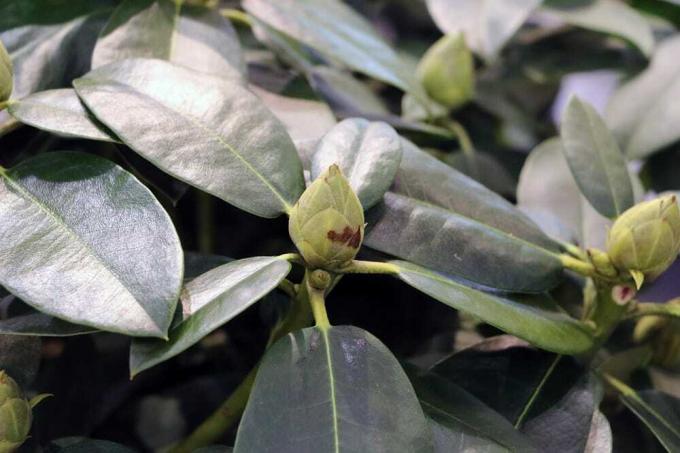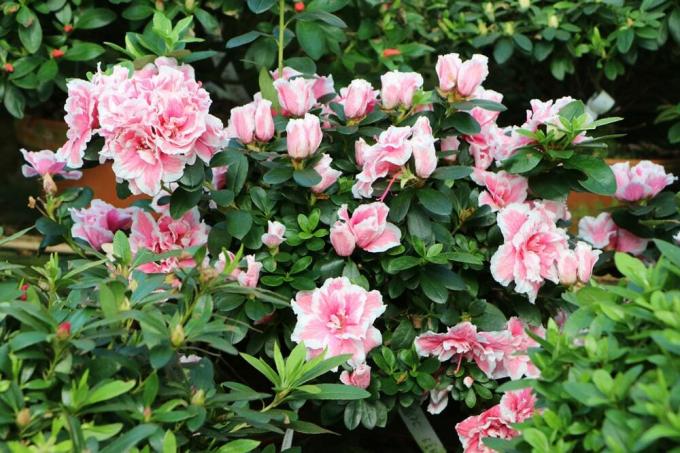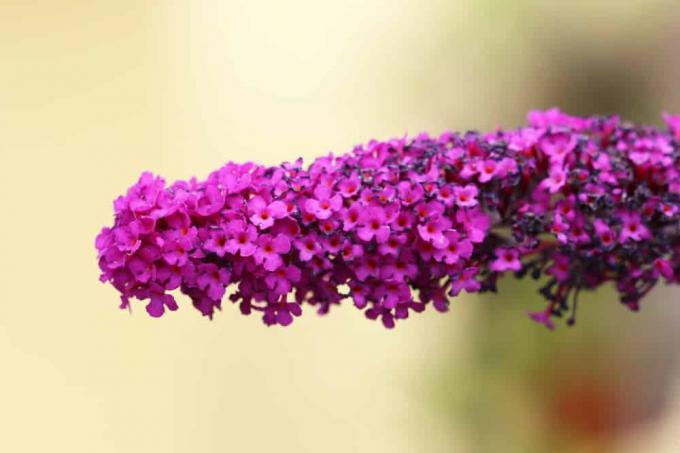

Table of contents
- growth
- Ideal site conditions
- Cut
- proper care
- species
The rhododendron belongs to the heather family and is a beautiful addition to any garden. Due to the large number of species with different characteristics, the growth and the growth height that can be achieved also vary extremely. Depending on the species, the plants grow from dwarf shrubs to tree-shaped shrubs. Both site conditions and care have a major impact on growth.
growth
In general, rhododendrons grow very slowly, only after many years do the plants reach their final growth height and width. Breeding means that there are now large and faster-growing species to choose from, as well as small dwarf varieties. Most of the flowering shrubs are evergreen, while deciduous varieties are less common. If you choose rhododendrons to create a hedge or as an ornamental shrub, you will enjoy the magnificent flowers for a long time. Due to the dark green and well-growing foliage, the plants grow into a dense hedge over time, which serves as a privacy screen for the garden. Before selecting the variety, it is important to consider the conditions at the desired location, as these factors have an extreme impact on growth. If the shrubs get the right place, the maintenance measures are also simplified.
- Predominantly robust, winter-hardy and flowering shrubs
- Growth heights vary depending on the variety
- Plants have a compact habit
- Leaves and flowers are just as different
- Shrubs grow quite slowly
- However, the growth is more magnificent from year to year
- Shrubs can become extremely old
- The right site conditions are extremely important
- Proper care has a positive effect on growth
- Blossoms enchant with their varied color palette
- Color spectrum includes blue-violet, yellow, pink, red to white
Ideal site conditions

The rhododendron is a sensitive plant and places certain demands on its location. Failure to meet these conditions will have a detrimental effect on growth. Young plants in particular are very sensitive to strong sunlight, while older specimens become much more resistant over time. When the rhododendron has grown large, it needs much more light. Therefore, locations are ideal where the incidence of light increases as the plant grows. If the rhododendron has become too large for its current location, it is advisable to transplant it instead of cutting it back. Diseases can also lead to stunted growth, although they are rare, they are promoted by unfavorable site conditions and poor care. Due to the fine roots, heavy clay soil is unsuitable for the plants.
- Thrives best in partial shade
- Mild temperatures are ideal
- Location should be sheltered from the wind
- Full sun and intense heat will initially stunt growth
- Prefers acidic soils with a pH of 4.0 to 5.5
- Does not tolerate calcareous soil qualities
- Floor must be water and air permeable
- Loosen the soil well before planting
- Avoid waterlogging at all costs
Tip:
If the soil quality is not right at the desired location, then the soil should be additionally enriched. A mixture of humus with special rhododendron soil is ideal.
Cut
If the rhododendrons are still young, it makes sense to give them a pruning to give them a shape. In this way, a compact growth is promoted, especially if the space available to the sides is rather limited. Very densely growing bushes should be thinned out so that light can continue to fall into the crowns. Vigorous and healthy plants will sprout again in abundance after the pruning measures, and the abundance of flowers will also increase. If the plants are cultivated in tubs, they must be repotted as they grow taller and wider. When repotting, it is advisable to shorten the root system. This activates the formation of new roots and stimulates general growth.
- Regularly pluck out withered and dried-up parts of the plant
- Cut off diseased and frostbitten shoots
- Break off faded umbels
- Cut back dead and poorly developed shoots
- Stunted growing specimens need radical pruning for rejuvenation
- The right time for pruning is after flowering
- The plant then forms buds again until autumn
- Pruning stimulates new growth
- After that, the growth is bushier and more branched
proper care

Regular watering and long-term fertilization are extremely important for rapid and dense growth. Especially newly planted or freshly cut specimens need a lot of water, they also have to be watered in rainy weather. In contrast, older and already well-rooted specimens can regulate their water balance independently when normal weather conditions prevail. Although the plants need sufficient watering, if the roots are permanently too wet, the plants die quickly. The root system of the rhododendrons is fine-fibrous and is close to the surface. Therefore, the soil around the wood should not be hacked through, as this can lead to serious injuries to the roots. In addition, other shallow roots should be avoided as plant neighbors of the rhododendrons, otherwise the resulting root competition will negatively affect growth.
- Always keep the soil slightly moist, but never too wet
- After rooting, weekly watering units are sufficient
- Use only lime-free water
- Collected rainwater is ideal
- As an alternative, you can use stagnant tap water
- It is best to fertilize from May to September
- Organic fertilizers with magnesium and iron are ideal
- These include horn shavings, cattle manure and blue grain
- Rhododendron fertilizers offer a perfect mixing ratio
- Special fertilizers lower the pH value
- Protect from cold winds in the winter months
A notice:
If the tap water in the region is extremely hard, it can be softened with peat. Just hang a bag with some peat in the watering can for a day.
species

Every spring, the local gardens and parks shine in a bright sea of colour. The reason for this are the imposing rhododendrons, which have become very popular in this country. More than 1,000 species are now known, most of which are found in the northern hemisphere. Rhododendrons work very well as hedges and as plantings between larger neighboring trees.
- Creeping species only grow up to 30 cm high
- Well suited for rock gardens, tubs and as a houseplant
- Half-height species reach growth heights between 1 and 1.5 m
- Ideal for flower borders and as an ornamental shrub in the front yard
- Tall species grow to over 2 m
- Can be combined with each other in shrub borders
- Ornamental as a solitary plant in a single stand
Barbarella
- Modern breed with flowers in orange, yellow, red and pink
- small-flowered, but extremely floriferous
- Flowering time in May
- Grows extremely slowly
- After ten years it will be about 35 cm high
- Reaches width of 60 cm
Catawbiense grandiflorum
- Evergreen variety with lilac colored flowers
- Blooms from May to June
- Extremely frost hardy and robust
- Maximum growth height is 2 to 3 m
- Maximum width is 2 m
- Grows 20 to 30 cm per year
Cunningham's White
- Evergreen variety with large and white flowers
- Blooms from May to June
- Very robust and frost-resistant
- Maximum height is 2 m
- Maximum width is also 2 m
- Grows up to 20 cm per year
Germania
- Evergreen variety with dark pink flowers
- Flowers from May to June, very decorative
- Extremely hardy and easy to care for
- Maximum growth height is 2 m
- Maximum width is also 2 m
- Grows about 10 cm per year
gold prince
- Decorative Yakushimanum hybrid
- Forms intense golden yellow flowers
- Slightly ruffled petals with dark mottled spots
- Flowers from mid-May
- After ten years, it becomes about 70 cm high
- Reaches width of 90 cm
- Needs extra protection in harsh winters
Gomer Waterer
- Evergreen variety with light pink to white flowers
- Blooms from May to June
- Frost-resistant and easy to care for
- Maximum growth height is 2 m
- Maximum width is also 2 m
- Grows about 10 cm per year
Madam Masson
- Evergreen variety with white flowers
- The yellow center of the flower is particularly decorative
- Blooms from May to June
- Very frost hardy and easy to care for
- Maximum growth height is 2 to 3 m
- Maximum width is 2 m
- Grows 20 cm per year
Marcel Menard
- One of the oldest and most popular varieties
- Wintergreen with dark purple flowers
- Flower center is orange-brown
- Blooms from May to June
- Very frost hardy and easy to care for
- Maximum growth height is 2 m
- Maximum width is also 2 m
- Grows 20 cm per year
Nova Zembla
- Evergreen variety with red flowers
- Blooms from April to May
- Very frost hardy and easy to care for
- Maximum growth height is 2 m
- Maximum width is also 2 m
- Grows 20 cm per year
red jack
- Evergreen variety with red flowers
- Blooms from April to May
- Only conditionally hardy, tolerates temperatures down to -10 °C
- Does not like cold and windy locations
- Maximum growth height is 2 m
- Maximum width is also 2 m
- Grows about 20 cm per year
Roseum elegans
- Evergreen variety with lilac to pink flowers
- Blooms from May to June
- Very hardy and decorative
- Maximum growth height is 2 to 3 m
- Maximum width is 2 m
- Grows 20 to 25 cm per year
 Home editorial office
Home editorial office
Learn more about shrubs and woody plants

17 flowering hardy plants May to October
Many plants only show their full splendor for a short time. But there are also types and varieties with a particularly long flowering period from May to October, sometimes even longer. We present 17 flowering hardy plants.

25 hardy and evergreen ornamental trees
Ornamental trees are among the most popular plants in the garden. They have a decorative effect and set special accents in the green oasis. If you are tired of the gray of the cold season, you can plant trees that are hardy and evergreen.

Is barberry poisonous? | What is to be considered?
With their dense growth, numerous thorns and evergreen foliage, barberries are one of the most popular types of plants for a hedge in the garden. Before cultivating the sour thorn family (Berberidaceae), many ask themselves whether the plant is poisonous.

Azalea location: 6 important criteria
Azaleas are a flowering addition to the garden or living room, as long as they are in the right location. In the following guide to azaleas, we will tell you what to look out for.

Butterfly bush: the ideal location | Buddleia
The uncomplicated, easy-care and robust butterfly bush is suitable in the garden for borders, a flowering hedge or as a solitaire. Dwarf summer lilacs are ideal for pot culture. Buddleia bloom from June to October and are a magnet for many butterflies.

How poisonous is summer lilac? | butterfly lilac
Just in time for the beginning of the beautiful season, magnificently blooming butterfly bushes are omnipresent. The opulent flowering shrub is just as common in nature as it is in private gardens and public parks. Concerned parents and animal lovers are asking how poisonous Buddleia is. Read an informed answer here.



